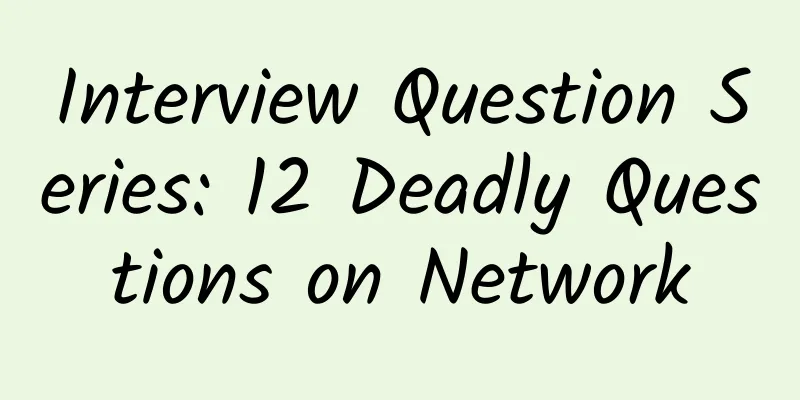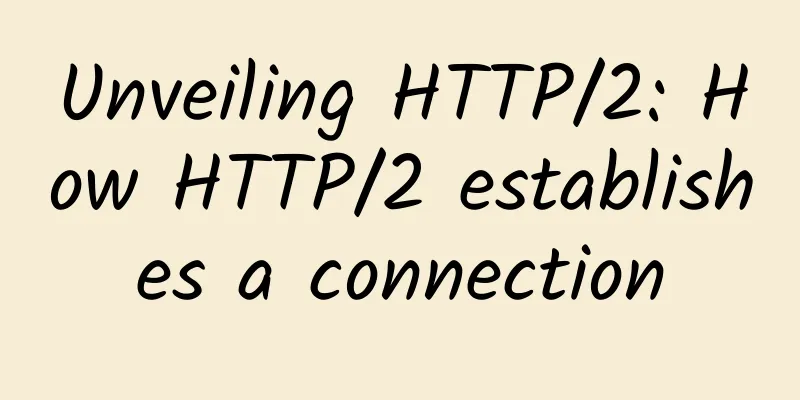Interview Question Series: 12 Deadly Questions on Network

1. What is your understanding of the TCP/IP four-layer model and the OSI seven-layer model?In order to enhance versatility and compatibility, computer networks are designed as hierarchical structures, with each layer following certain rules.
Therefore, there is an abstract network communication reference model such as OSI, which allows computer network systems to be connected to each other according to this standard.
TCP/IP is a four-layer structure, which is equivalent to a simplification of the OSI model.
To sum up, the physical layer connects computers through physical means, the data link layer groups the bit stream data, the network layer establishes host-to-host communication, the transport layer establishes port-to-port communication, and the application layer is ultimately responsible for establishing the connection, converting the data format, and finally presenting it to the user. 2. What is the process of TCP 3-way handshake?The server needs to listen to the port before establishing a connection, so the initial state is LISTEN.
3. Why 3 times? 2 or 4 times?Because TCP is a duplex transmission mode, it does not distinguish between the client and the server, and the establishment of a connection is a two-way process. If there are only two times, a two-way connection cannot be established. It can be seen from the fact that the SYN and ACK replied by the server when establishing the connection are combined into one time, it does not need four times. Why wave four times? Because the ACK and FIN of wave cannot be sent at the same time, because the deadline for data sending is different. 4. What about the process of four waves?
5. Why do we have to wait for 2MSL to shut down?
6. How does TCP ensure the reliability of the transmission process?Checksum: The sender calculates the checksum before sending the data, and the receiver does the same after receiving the data. If they are inconsistent, then the transmission is incorrect. Confirmation response, sequence number: When TCP is transmitted, the data is numbered, and each time the receiver returns ACK, there is a confirmation sequence number. Timeout retransmission: If the sender does not receive ACK after sending data for a period of time, it will resend the data. Connection management: three-way handshake and four-way wave process. Flow control: The TCP protocol header contains a 16-bit window size. The receiver will fill in its own immediate window when returning ACK, and the sender will control the sending speed according to the size of the window in the message. Congestion control: When data is first sent, the congestion window is 1. Each time an ACK is received, the congestion window is increased by 1. The smaller value of the congestion window and the received window is used as the actual sending window. If a timeout retransmission occurs, the congestion window is reset to 1. The purpose of this is to ensure the efficiency and reliability of the transmission process. 7. What is the process of a browser requesting a URL?
8. Do you know how HTTPS works?
9. What are the implementation methods of load balancing?DNS: This is the simplest load balancing method, generally used to achieve geographical load balancing. Users in different regions can return different IP addresses through DNS resolution. This type of load balancing is simple, but its scalability is too poor, and the control lies with the domain name service provider. Http redirection: load balancing is achieved by modifying the Location field in the Http response header, using Http 302 redirection. This method affects performance and increases request time. Reverse proxy: A mode that acts on the application layer, also known as layer-7 load balancing, such as the common Nginx, which generally has a performance of 10,000. This method is simple to deploy, low-cost, and easy to expand. IP: This mode acts on the network layer and the transport layer, also known as layer 4 load balancing, which achieves the effect of load balancing by modifying the IP address and port of the data packet. Common ones include LVS (Linux Virtual Server), which usually supports 100,000 concurrent connections. According to the type, it can also be divided into DNS load balancing, hardware load balancing, and software load balancing. Among them, hardware load balancing is expensive, but has the best performance, reaching the million level. Software load balancing includes Nginx and LVS. 10. What are the differences between BIO/NIO/AIO?BIO: Synchronous blocking IO, for each client connection, the server will correspond to a processing thread, and connections that are not assigned to a processing thread will be blocked or rejected. It is equivalent to one thread for each connection. NIO: Synchronous non-blocking IO, based on the Reactor model, the client communicates with the channel, the channel can perform read and write operations, and the multiplexer selector is used to poll the channels registered on it, and then perform IO operations. In this way, when performing IO operations, only one thread can be used to process, that is, one thread per request. AIO: Asynchronous non-blocking IO, which goes a step further than NIO. The operating system handles the request completely and then notifies the server to start a thread for processing. Therefore, one thread is effectively requested. 11. So how do you understand synchronization and blocking?First of all, you can think of an IO operation as consisting of two parts:
The difference between synchronization and asynchrony lies in the second one, the actual IO read and write operations. If the operating system completes it for you and then notifies you, it is asynchronous, otherwise it is called synchronization. The difference between blocking and non-blocking is that, first, an IO request is initiated. For NIO, after an IO operation request is initiated through a channel, it actually returns, so it is non-blocking. 12. What is your understanding of the Reactor model?The Reactor model consists of two components:
It includes several implementations: Single-threaded ReactorIn this mode, the reactor and handler are in the same thread. If a handler is blocked, all other handlers will be unable to execute and the performance of multiple cores cannot be fully utilized. Single Reactor MultithreadingSince decode, compute, and encode operations are not IO operations, the idea of the multi-threaded Reactor is to give full play to the characteristics of multi-core and separate non-IO operations. However, a single Reactor is responsible for all event monitoring and response work. If there are too many connections, there may still be performance issues. Multi-Reactor Multi-ThreadIn order to solve the performance problem of a single Reactor, a multi-Reactor model was created, where the mainReactor establishes the connection and multiple subReactors are responsible for data reading and writing. |
<<: Protocol-Oriented Programming and Cocoa (Part 2)
>>: Quick Start with Linkerd v2 Service Mesh
Recommend
With 30,000 layoffs, what have American operators experienced?
According to public data, the scale of layoffs at...
Explain the five major network concepts in a vivid and interesting way
The update of 5G technology has promoted the deve...
The benefits of modern networks for businesses
Enterprise adoption of software-defined and virtu...
Discussion | Technical advantages of the top 9 leading SD-WAN providers abroad
SD-WAN technology helps make wide area networks m...
When enterprises launch live streaming services, how can they avoid technology becoming a stumbling block?
[Original article from 51CTO.com] After experienc...
[Black Friday] DediPath: 35% off VPS/Hybrid Servers starting at $1.2/month, 1Gbps unlimited traffic, multiple data centers in Los Angeles and other places
DediPath's Black Friday discounts this year a...
Tencent Cloud Double 11 Early Purchase: 2C4G8M cloud server only 70 yuan/year, renewal can get coupons
Tencent Cloud has launched the Double 11 warm-up ...
An article on learning Go network library Gnet analysis
Introduction We analyzed the Go native network mo...
Comparative analysis of three types of CDN vendors: Technologically innovative ones lead the way
Preface: With the explosion of live video, the ri...
When porting your number to another network, operators should first change their service mindset
Because the Premier clearly pointed out in the go...
Traveling across China in the name of ecology, Huawei China ICT Ecosystem Tour 2017 exhibition vehicle officially launched
[Changsha, China, March 10, 2017] Huawei, the wor...
What is an access network?
Nowadays, whether it is the fixed network (broadb...
[11.11] Megalayer: US/Hong Kong dedicated servers starting from 299 yuan/month, 1Gbps dedicated servers starting from 499 yuan/month
Megalayer has launched a promotion during the Dou...
Why can a TCP connection only have "3-way handshake" and not 2 or 4?
We know that the communication modes between clie...
5G market is rapidly expanding and artificial intelligence scenarios are becoming a reality
[[183832]] In response to the explosive growth of...









